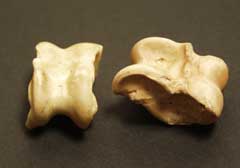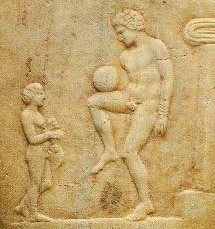- Hunting: was enjoyed by the aristocratic populace (slave bears, horses, dogs. Lion hunting; was the preview of royalty, a sport of nobility.

- Fishing: was seen as more of a job; Ancient sources mention one fishmonger winning the Olympia.
- Aquatic sports: such as swimming, were only used as a way of training for other sports (recreational, not competitive)
- Acrobatics: popular; used as children’s entertainment; NO evidence of competition.
- Children have their own games/ amusements (I.e juggling, teeter-totters, swings, (one particular game was a hoop, played in the streets, and was recommended by doctors as a healthy exercise that children could perform by themselves.
- Hoop: made from iron, bronze, or wood with small studs at regular intervals around the edge. Made loud, easily identifiable noise (help parents find children playing with it). The hoop was propelled by a wooden stick or iron rod (elater) and was supposed to stand chest-high.
- Another popular toy: is Yo-Yo. Believed to be made of wood, but no example of it has survived from ancient Greece.

- Tops: favored toys. No wooden tops survive, but terra-cotta and bronze ones do.
- Most common toys: knuckle-bones and dice
- Knucklebones: found in social and educational gatherings; found in graves and sanctuaries
- Made of tarsal bone/ ankle of sheep or goat; attached to the shinbone and the radius
- Has 4 sides and two rounded ends; don’t match; each assigned a different value [board sides: pranes= 4, hyption= 3] [shorter sides: chion= 1 koon: 6] each pair of sides has total value of 7.
- Fancier knucklebones were made of stone, metal, and glass, sometimes “loaded” to cheat.
- Momentum at Olympia of marble astragalos
- Astragaloi were a constant part of palaistra
- Dice: similar to modern dice; included games of chance like craps and board games; inventor: Palamedes (leader or Troy); more likely invented by the Egyptians.
- Ancient Greeks used balls for recreation and NOT athletics
- Harpaston “to grab away from”: small, hard, covered with leather Palla: lighter, feather-stuffed ball
- Episkyros (common ball): two opposing teams of equal men. Set the ball in the middle and throw the ball over the other team and continue until
 they finally get the ball over the backline
they finally get the ball over the backline - Aporrhaxis: bounce a ball vigorously and dribble it; count # of bounces
- Ourania: one player bending backward and throwing the ball into the sky. Other players try to grab it and dribble a ball against the wall, and count the number of bounces. Loser: donkey Winner: king…tell donkey and give him orders
- Ephedrismos (sitting on): setting stone at a distance and trying to hit it with balls or stones; Whoever doesn’t knock it over has to carry the one who did; eye held shut; until he finds the stone
- Ball game not described in written sources: older male carries younger male and throws pairs of young men. They then all scramble for the balls after it thrown
- Modern soccer scene is seen on a funerary monument (used folis air-filled leather-covered ball)
- In other modern games, athletes use curved sticks to move around small discs/balls using a horn (Keras) -> “use the horn.”
**Ball playing didn’t prepare future citizens in any meaningful way for their responsibilities; arête isn’t displayed on a team. Therefore it is not highly regarded or documented in ancient Greek culture.

This helped a lot. Thanks!
I really enjoyed this article
same!
thank you
Thank u this help me
this saved me thank you
hi, thank you very much
Thank you internet for your great help – I wouldn’t survive without this website
I know its awesome right!
thank you
Thanks 🙂
yep, thanks!
thank you very much
Thank you, I got all the information I needed on recreational activities!
This just saved my project 🙂
what is a slave bear
They should add citation help
Cool
hello,
Tell me more about some of the greek board games.